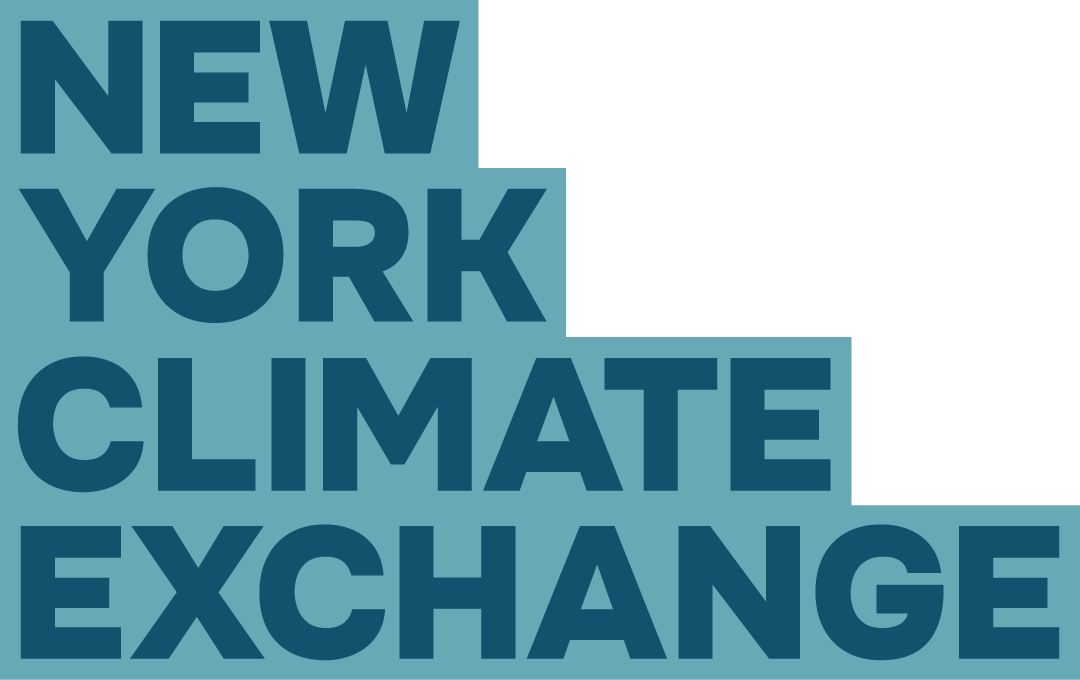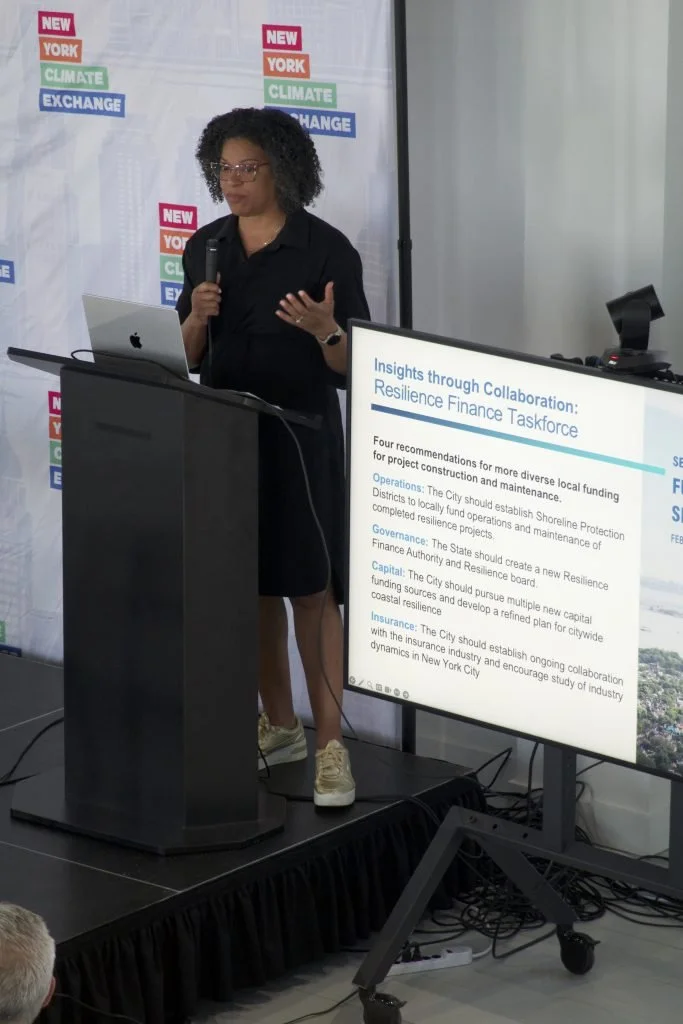Climate Solutions Summit NYC: Data. Decisions. Action.
In the heart of New York Harbor, with the New York City skyline as a backdrop, The New York Climate Exchange hosted its inaugural Climate Solutions Summit NYC on Governors Island. The Earth Week event (April 23–24, 2025), brought together scientists, community leaders, policymakers, artists, and innovators to address one of the most pressing challenges of our time: building climate resilience in coastal urban environments.
In partnership with the New York City Panel on Climate Change (NPCC) and the Urban Climate Change Research Network (UCCRN), the summit was grounded in data, environmental justice, and the power of partnerships.
A SCIENCE-DRIVEN CALL TO ACTION
Day one opened with a clear-eyed view of climate science in New York City. Members of the NPCC, established in 2008 by Mayor Michael Bloomberg shared insights from their fourth report (NPCC4) and a preview of NPCC5. NPCC4 delivered critical updates — projections aligned with IPCC models, a new flood vulnerability index, and a focus on equity. But what stood out most was the scientific community’s candid acknowledgment: there are still significant climate adaptation gaps, especially in water supply systems, air pollution, and communication strategies.
NPCC5 aims to close those gaps. Working groups are currently tackling the following priority areas:
Better climate science communications
Integration of water supply and air pollution into assessments
Improved urban natural systems management
Increased safeguarding of critical infrastructure
The Summit continued with a flash talk series on “Using Science to Assess Needs and Advance Solutions.” Here, the power of interdisciplinary collaboration came into focus.
Guanyu Huang from Stony Brook introduced an AI-based tool for identifying disparities in nitrogen dioxide (NO₂) exposure across New York’s metro area. Meanwhile, Shari Rose of the American Geophysical Union reminded attendees of the human stories behind the data, advocating for ethical, inclusive community engagement.
Angela Wong shared how the Port Authority integrates NPCC projections into its infrastructure decisions, leveraging a digital platform for stakeholder collaboration. Financial and environmental risks intersected as Jennifer Chang from Moody’s discussed flood insurance trends, while Ana Porzecanski and Amanda Sigouin of the American Museum of Natural History highlighted the need for applied, nature-based solutions.
These talks echoed a shared truth: solving climate challenges requires not only scientific rigor, but collaboration across sectors and communities. From corporate boardrooms to coastal neighborhoods, to museum exhibits, research labs, and public infrastructure boards — the future is collaborative.
YOUNG MINDS, BOLD IDEAS
Halfway through the day, the Summit floor transformed into a gallery of emerging research. Posters from students and partners — including Empire Clean Cities, the Harbor School, and UCCRN — offered a snapshot of tomorrow’s climate leaders in action.
The afternoon’s flash talks, “The Role of Data Collection and Sharing in Informing Solutions,” spotlighted breakthrough tools and frameworks. Presenters shared how NYU, Columbia/NASA, and Climate TRACE are reshaping resilience strategies with real-time monitoring, AI-driven emissions mapping, and predictive infrastructure models.
One standout came from Georgia Tech, where researchers are co-designing culturally grounded sensors with Indigenous communities — bridging modern science and ancestral knowledge to monitor sacred lands. Data isn’t just information, it’s empowerment.
The day’s final panel, “Enabling Environmental Observations on the Island,” reimagined Governors Island as a hub for climate science and public engagement. The proposal: establish the Governors Island Environmental Observatories (GIEO), a bold vision led by Stony Brook’s Paul Shepson.
Other panelists outlined the Island’s potential for real-time air quality monitoring, methane emissions tracking, and integrated data systems. Its low-emission baseline and unique airflow make it a perfect candidate for a living laboratory. More than just a lab, GIEO could become a public-facing gateway to climate science — where visitors engage with live data and students contribute to long-term studies. The session closed with calls to incorporate student training, community participation, and sensor networks into the Observatory’s design.
TURNING DIALOGUE INTO DIRECTION
Day one ended with ideas for catalyzing action. Attendees broke into interdisciplinary groups to brainstorm next steps for The Exchange and its partners. The ideas were bold: community-driven data collection, co-developed pilot projects, nature-based solutions, and experiments in urban sustainability.
What unified these proposals, and really got the Exchange team excited, was a sense of shared ownership — researchers, government agencies, nonprofits, and residents collaborating on solutions that are both scientifically sound and socially grounded.
BUILDING COASTAL RESILIENCE TOGETHER
Day two began with a powerful keynote from Laurian Farrell, NYC’s Deputy Commissioner for Coastal Resilience. Her talk, “Building Coastal Resilience Together,” painted a stark but hopeful picture: 520 miles of vulnerable coastline, billions in infrastructure needs, and an urgent call to redefine resilience as the ability to not just withstand, but to adapt and thrive.
Farrell outlined the City’s evolving vision — a $51B infrastructure plan, the creation of a Bureau of Coastal Resilience, and recommendations from a newly launched Resilience Finance Task Force. But it was her emphasis on partnership that resonated most: real progress, she stressed, depends on weaving together human, social, physical, natural, and financial capital.
The next panel, “Building Partnerships to Advance Coastal and Flood Resilience,” showcased how collaboration can shape real-world outcomes. Speakers from The Nature Conservancy, Pace University, New York Sea Grant, and the Waterfront Alliance emphasized that successful projects grow from trust, transparency, and community priorities. Examples like FloodNet and the Bronx Point development illustrated what’s possible when local voices guide design and decision-making.
Panelists stressed that top-down approaches often miss the mark. Instead, communities must co-lead. Effective partnerships recognize the capacity of all stakeholders, avoid deficit narratives, and reward collective success. The message was clear: equity is not a side goal—it’s the foundation of lasting climate resilience.
ART, EQUITY & ADAPTATION: LESSONS FROM COLLABORATION
In the final flash talk series, “Lessons Learned from Collaborative Approaches,” a rich tapestry of ideas unfolded. David Erdman of Pratt’s Center for Climate Adaptation explored how design workshops in NYC, Singapore, and Argentina help co-create infrastructure that is resilient and beautiful.
Olaitan Falade of the Climate and Health Equity Foundation emphasized the health impacts of flooding in underserved communities, calling for better data sharing and public trust. Pamela Ginex of Stony Brook University highlighted how climate disasters disrupt healthcare systems, and how student involvement and global cooperation can strengthen responses.
Corinne LeTourneau of Resilient Cities Catalyst brought a small business perspective, sharing how partnerships have helped entrepreneurs weather climate challenges. Moe Yousuf of LMCC urged early inclusion of artists in climate planning to deepen engagement and create work that resonates with the public.
These stories revealed the multifaceted nature of resilience — where science, health, art, and economy intersect in complex but powerful ways.
WHAT COMES NEXT: THE CLIMATE-READY FUTURE OF GOVERNORS ISLAND
As the summit closed, The Exchange and its partners outlined next steps for urgently transforming Governors Island into a climate innovation hub:
Create new research collaborations centered on community-driven resilience science.
Launch an air quality and greenhouse gas monitoring lab to support real-time data collection and policy development.
Explore a full-spectrum environmental observatory examining ecosystems from canopy to soil — blending science, art, and public participation.
Establish a public-facing “living lab” that inspires action through immersive education, exhibitions, and hands-on research.
Develop training programs to help communities, students, and educators interpret climate data and tell their own stories.
Consider an annual climate perspectives report and event series to track and amplify public views and local insights.
A NEW MODEL FOR URBAN CLIMATE SOLUTIONS
The 2025 Climate Solutions Summit NYC demonstrated that Governors Island is so much more than a retreat. It’s a hub for innovation and solutions, and a platform for examining technical issues that are lifelines for New York City’s future. Attendees left the meeting with a vision of what’s possible when science, community, and creativity meet.






